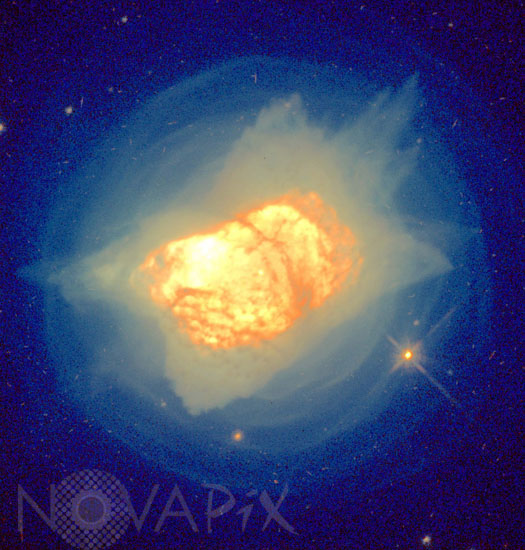Photo Agency - Astronomy - Space - Nature

Planetary nebula NGC 7027 in Cygnus
author: Nasa/Stsci/Novapix
reference: a-nep70-27001
Image Size 300 DPI: 16 * 17 cm
This NASA Hubble Space Telescope image of planetary nebula NGC 7027 shows remarkable new details of the process by which a star like the Sun dies. New features include: faint, blue, concentric shells surrounding the nebula; an extensive network of red dust clouds throughout the bright inner region; and the hot central white dwarf, visible as a white dot at the center. The nebula is a record of the star's final death throes. Initially the ejection of the star's outer layers, when it was at its red giant stage of evolution, occurred at a low rate and was spherical. The Hubble photo reveals that the initial ejections occurred episodically to produce the concentric shells. This culminated in a vigorous ejection of all of the remaining outer layers, which produced the bright inner regions. At this later stage the ejection was non-spherical, and dense clouds of dust condensed from the ejected material. NGC 7027 is located about 3,000 light-years from Earth in the direction of the summer constellation Cygnus. When a star like the Sun nears the end of its life, it expands to more than 50 times its original diameter, becoming a red giant star. Then its outer layers are ejected into space, exposing the small, extremely hot core of the star, which cools off to become a white dwarf. Although stars like the Sun can live for up to 10 billion years before becoming a red giant and ejecting a nebula, the actual ejection process takes only a few thousand years. The NGC 7027 photograph is a composite of two Hubble images, taken in visible and infrared light, and is shown in "pseudo-color."
Keywords for this photo:
1996 - ASTRONOMY - CYGNUS - DWARF - DYING STAR - EVOLUTION - HST - HUBBLE SPACE TELESCOPE - NEBULA - NGC 7027 - PLANETARY NEBULA - STAR - WHITE DWARF -
Contact : Stéphane Aubin +33-(0)9-51-26-53-76
© Novapix - All rights reserved


